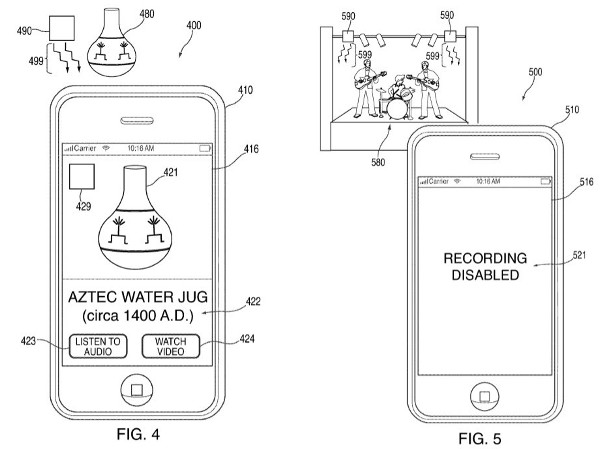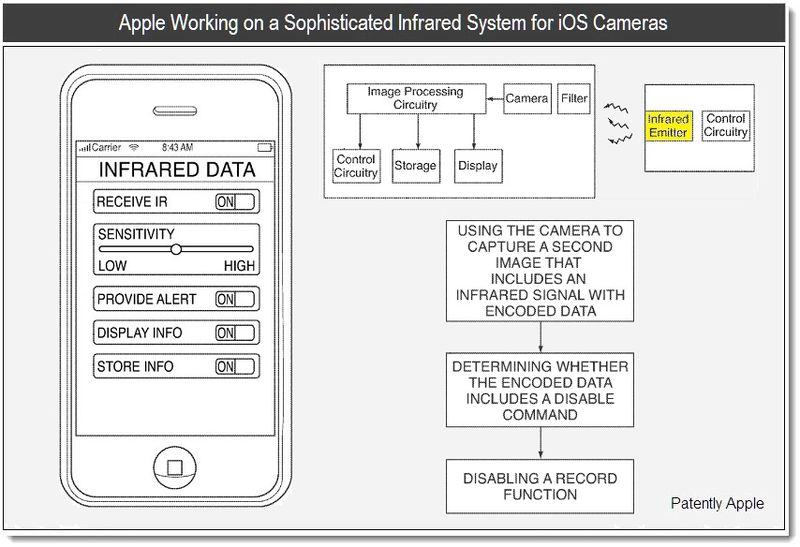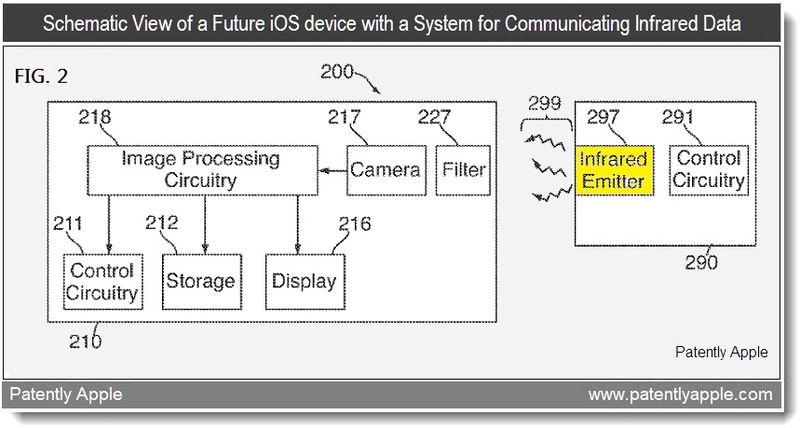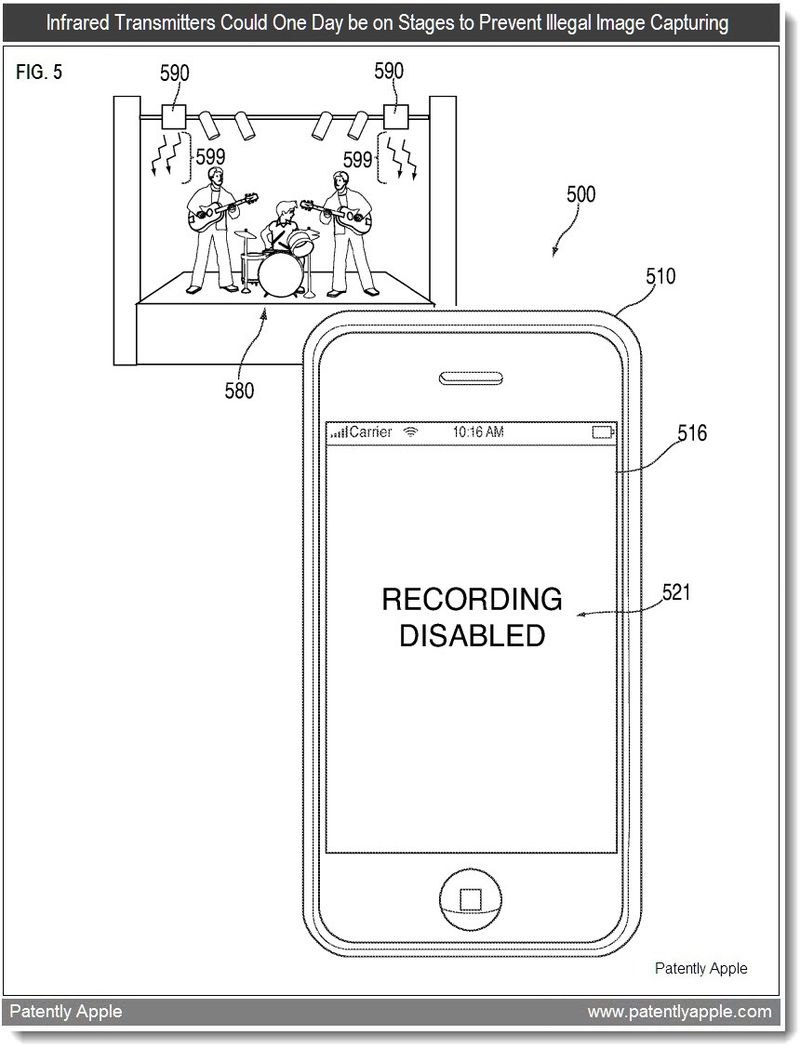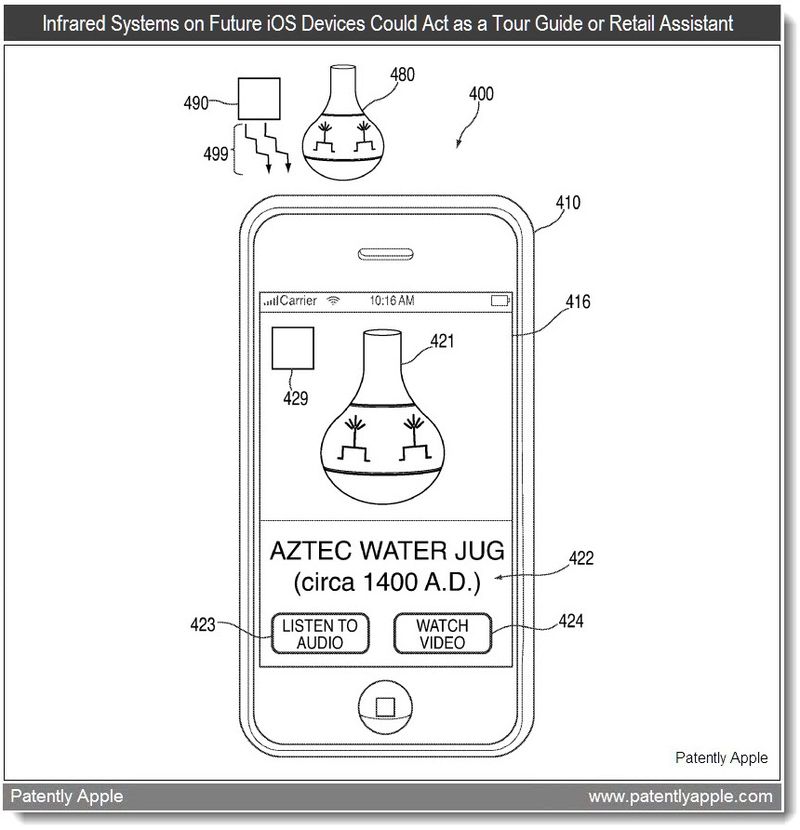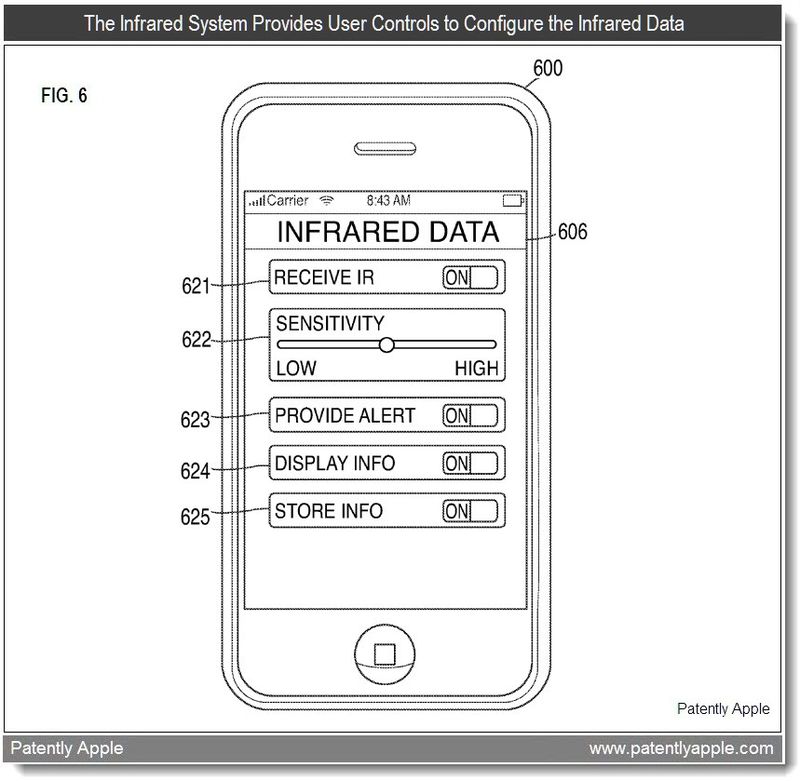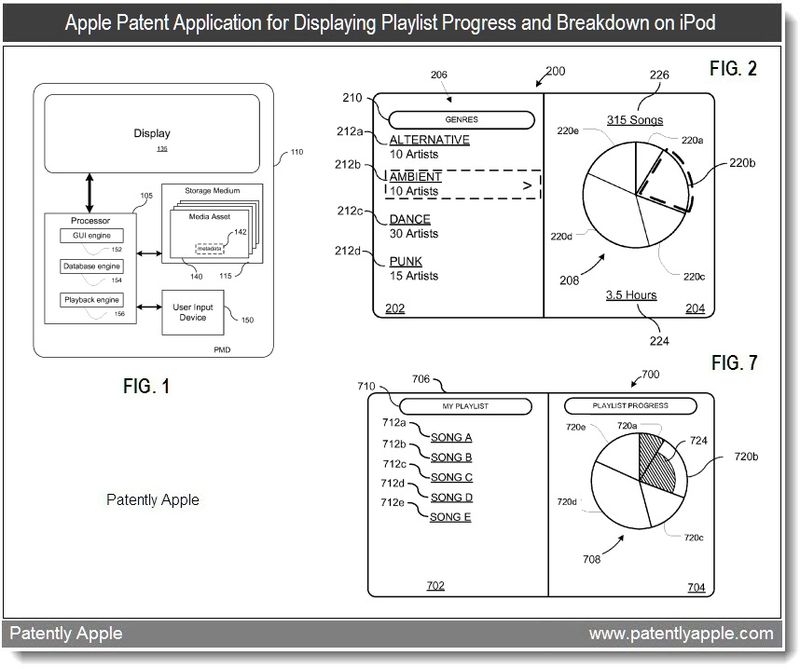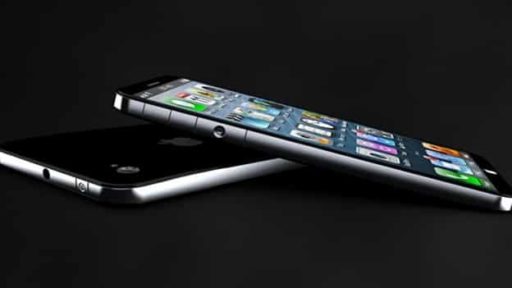Apple is always filing patents for strange and fantastic things that never seem to find their way into actual products, but an application published which details some interesting tech that we could actually see getting jammed into a future iPhone. By pairing an infrared sensor with the camera already on board, portable devices could receive data from transmitters placed and opening links like a glorified QR code, transmitters could disable certain features, such as the camera, to prevent recording at movie theaters and music venues………..
Apple evealed various concepts behind a newly advanced next generation camera system that could employ infrared technology. On one side, the new system would go a long way in assisting the music and movie industries by automatically disabling camera functions when trying to photograph or film a movie or concert. On the other hand, the new system could turn your iOS device into a kind of automated tour guide for museums or cityscapes as well as eventually being an auto retail clerk providing customers with price, availability and product information. The technology behind Apple‘s patent application holds a lot of potential. Many electronic devices include cameras designed to detect images. For example, a traditional cellular telephone or portable media player may include a camera. Such cameras can typically detect images based on visible light but do not receive any data communications through either visible or invisible light. Accordingly, the functionality of cameras in traditional electronic devices is limited. Apple’s patent describes systems and methods for receiving infrared data with a camera designed to detect images based on visible light. A system could include a camera and image processing circuitry electrically coupled to the camera. The image processing circuitry could determine whether each image detected by the camera includes an infrared signal with encoded data.
If the image processing circuitry determines that an image includes an infrared signal with encoded data, the circuitry may route at least a portion of the image (e.g., the infrared signal) to circuitry operative to decode the encoded data. If the image processing circuitry determines that an image does not include an infrared signal with encoded data, the circuitry may route the image to a display or storage. Images routed to the display or storage could then be used as individual pictures or frames in a video because those images don’t include any effects of infrared light communications. Based on the decoded data, a device could display information to a user or modify an operation of the device. In some embodiments, a device could, based on received infrared data, display information to a user relating to an object near the user. For example, an infrared emitter could be located near an object and generate infrared signals with encoded data that includes information about that object. The electronic device could then receive the infrared signals, decode the data and display the information about the object to the user.
In some embodiments, a device could, based on received infrared data, disable a function of the device. For example, an infrared emitter could be located in areas where picture or video capture is prohibited, and the emitter could generate infrared signals with encoded data that includes commands to disable the recording functions of devices. An electronic device could then receive the infrared signals, decode the data and temporarily disable the device’s recording function based on the command. The nfrared emitter could include an infrared light-emitting diode (LED). In some embodiments, the infrared emitter may emit a strobe of infrared light that cameras in the same general area of the transmitter could detect, regardless of the direction the cameras are facing. For example, the transmitter could function as a beacon generating an infrared signal that is easy for cameras to detect. In other embodiments, the infrared emitter may emit a directed beam of infrared light that only cameras in the path of the beam could detect. For example, the transmitter could function as a “spot light” generating an infrared signal that could only be received by cameras generally in front of the transmitter.
As an example of why this would be incorporated into cameras is explained as follows. A transmitter could be located adjacent to a museum exhibit and its infrared signal could include encoded data that represents information about the exhibit. In some embodiments, the infrared signal could include encoded data that represents a command. For example, the transmitter could be located in an area where photography is prohibited and the infrared signal could include encoded data that represents a command to disable recording functions. This example could easily apply to movie theatres trying to stop customers from filming a movie for illegal distribution or any kind of music concert to protect an artist’s image from being photographed or videoed illegally. In some embodiments, a device may apply a watermark to detected images as an alternative to completely disabling a recording function. For example, a device may receive infrared signals with encoded data that includes a command to apply a watermark to detected images. In such an example, the device may then apply the watermark to all detected images that are displayed or stored (e.g., single pictures or frames of a video). This feature could be convenient, depending on how this is applied.
For instance, let’s say you’re on vacation and visiting an aquarium, zoo or museum. That particular establishment could adjust their infrared system so as to automatically generate a watermark on the photos you take so that it identifies that particular establishment, such as: The Vancouver Zoo or The Monterey Aquarium or The New York Metropolitan Museum of Art. Apple could conveniently build that kind of feature into iOS cameras for an update to a feature like “Places.” The transmitter could be located adjacent to an object. For example, the object 480 is an Aztec water jug that could be on exhibit at a museum and the transmitter could be located adjacent to the object. In some embodiments, the transmitter could include visible indicia that also convey information about an object. For example, the transmitter could be in the form of a plaque with writing that conveys information about an object. Apple’s iOS device display could provide options for a user to obtain additional information or content about an object, such as the Aztec water jug as noted in the patent graphic. For example, the iOS device could include an audio option (shown as option 423) that a user could select to request a prerecorded audio segment and video option that a user could select to request a prerecorded video segment.
Apple makes it clear that their infrared system could obviously work in differing environments beyond tourist attractions. It could be applied to a retail environment so as to inform users of retail information on any given item in the store such as price, availability, discount status or any other relevant data that the retailer thinks will assist their customers in making a decision to make a purchase. A configuration screen could include options corresponding to one or more functions performed based on received infrared data. In some embodiments, provided options may include corresponding alerts when receiving infrared data. For example, a user may set option 623 to “OFF” so that the device will not provide any alerts when receiving infrared data. When set to “ON,” the iOS device could provide an audio alert (e.g., a chime), a visual alert (e.g., an icon), a tactile alert (e.g., a vibration), or any combination thereof in response to receiving infrared data. A 2008 continuation patent (20110131495) titled “Graphical Representation of Assets Stored on a Portable Media Device” surfaced today which also relates to a provisional patent dating back to 2007. The patent application relates to the integration of progress based GUI’s displaying various information on your about playlist progress and/or breakdown of your playlist by genre. Although I’ve seen a progress bar displaying how much space was left on my iPod, I’ve never seen charts as those presented below. If you have, then send in a comment describing which iPod model it was on.
Another continuation patent application that surfaced today (2010130140) covers their 2006 patent application and one that Apple was granted a patent for in January 2011. In that report we stated the following: “It’s an interesting read but you have to put it into proper context. Firstly, Apple isn’t seen in this patent as the “MVNO” as some would hope for. Secondly, the “bidding” system goes out to a series of MVNO’s which would confirm that Apple wasn’t planning on being the MVNO. Thirdly, the patent was filed in 2006 – well before any iPhone announcement was made. So this patent may simply have been Apple’s backup plan if their original talks with Cingular would have failed.” Considering that it’s already a granted patent, you have to wonder why they’re back tinkering with the idea. And lastly, Apple’s patent application 20110130958 titled dynamic alerts for calendar events is, according to Apple’s application, related to two older patents dating back to 2008 and 2009.
Source
[ttjad keyword=”iphone”]

